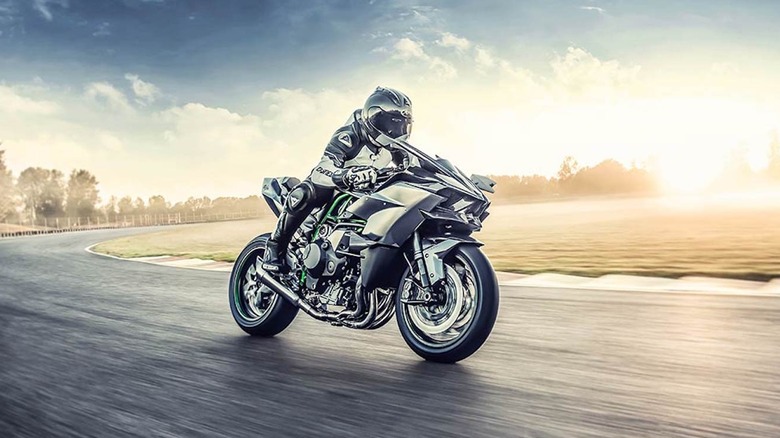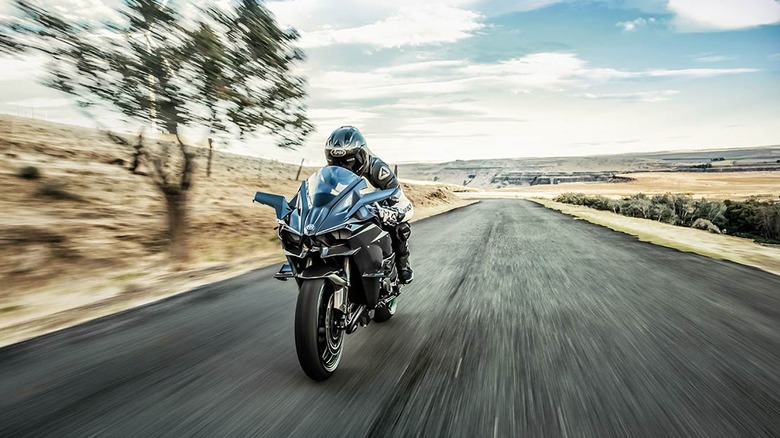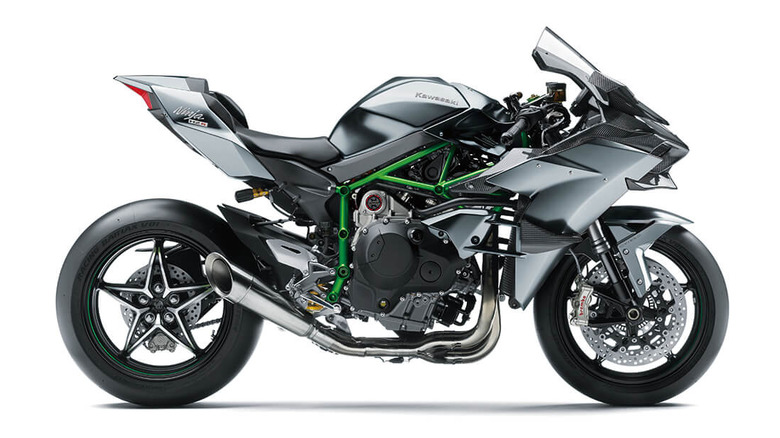Kawasaki Ninja H2R: Why This Motorcycle Is Historically One-Of-A-Kind
The Kawasaki Ninja H2R is a fast motorcycle, but it's a lot more than that. Modern motorcycles are small and lightweight, at least in most cases. Compared to cars, there's a lot less going on, so it's relatively easy these days to get an impressive power-to-weight ratio. Install a simple two, three, or four-cylinder engine into a frame, throw some fairings on, and you've already got the beginnings of a pretty fast machine. The H2R, however, goes to serious lengths to be one of the fastest motorcycles on earth.
Powered by a supercharged 998cc four-cylinder engine, the H2R is a rarity in the motorcycle world. Ultra-low numbers of forced-induction motorcycles exist in the world, fewer still that put out the kind of power provided by the H2R. According to Kawasaki, the H2R puts out 321.5 horsepower at 14,000 rpm and 121.5 lb-ft of torque at 12,500 rpm.
That's more than many modern hatchbacks, sedans, and SUVs. On a motorcycle that weighs just 476 pounds, there's little else that you can buy from any manufacturer that can compete. To put that in perspective, let's look at the BMW M 1000 RR — one of the fastest bikes you can buy today. It produces 205 hp and weighs 427 pounds, so the H2R only weighs about 50 pounds more, but it has over 50% more power.
More than just fast, it's built with purpose
The H2R is impressive for its power and the unique nature of its supercharged engine, but there are a lot of other ingredients that help make up the H2R's secret sauce. The H2R was built by several different divisions of Kawasaki. The motorcycle team paired up with Kawasaki Heavy Industries, who supplied the supercharger as well as other bits and pieces of the H2R. Like modern aircraft, the H2R uses highly specialized aerodynamics in pursuit of speed. For example, dog teeth and strakes are used on the front body work, which provides downforce but with a minimum increase in air resistance.
The H2R's frame was part of the specialized build process too. Referred to as a trellis frame, it is built using specialized welding techniques that focus on the beauty of the weld. The welds are evaluated during the build process to make sure that they're flat, constant, and without any spatter. And to get all this welding right, Kawasaki developed a specialized robot welder to help put it all together.
Of course, you want your specially-welded H2R to look good when it's painted, so Kawasaki introduced brand-new painted processes to apply the silver mirror paint to the body of the H2R. The paint itself is scratch-resistant and, according to Kawasaki, it can repair itself over time. All of this combines for a motorcycle that's not just fast, but special in ways that only eagle-eyed enthusiasts will be able to spot.
Speed like that will cost a pretty penny
Superbikes aren't cheap, but the H2R takes things to a different level. The venerable and properly-fast Yamaha R1, for example, currently costs $20,874 (including $625 destination fee and $1,250 supply chain surcharge). The racetrack-ready version, the R1M, costs almost $10,000 more.
Remember the BMW M 1000 RR we mentioned earlier? The 2026 model is one of the most expensive bikes you can buy from BMW, with a starting price of $43,590 (including $665 destination fee). The 50% more power comparison from earlier nearly applies to pricing too, because the track-only Kawasaki Ninja H2R has a starting price of $59,915 (including $815 destination fee). The high starting price includes a lot of equipment, though.
On top of the supercharged four-cylinder you also get specialized electronics (launch control, traction control, anti-lock brakes), Brembo Stylema brake calipers, and Öhlins suspension. Even the wheels are special. They're made from lightweight cast aluminum, made special via the Kawasaki WorldSBK team, and fitted with a 200-milimeter wide rear tire (both the front and rear tires are track-only slicks). Pair that with the carbon fiber used in a number of the body panels, and you've got a series of expensive materials used to make a bike that's surprisingly light for its performance capabilities. With all that performance gear and power, the H2R set a world record by going 400 kph (248 mph) across a bridge in Turkey. That's not something you can say about just any-old superbike.


